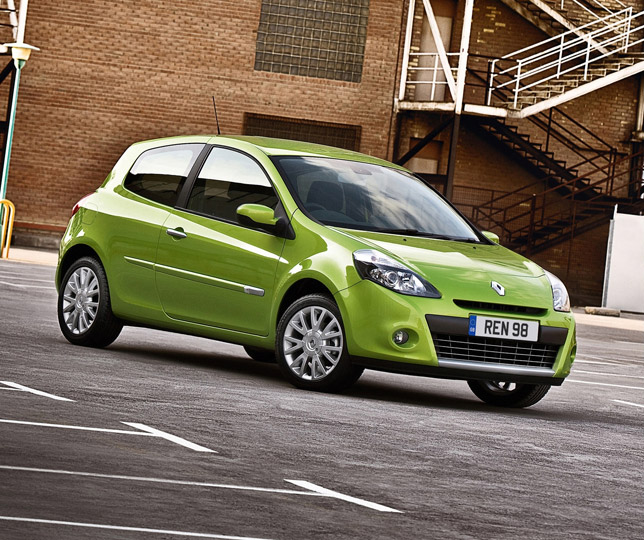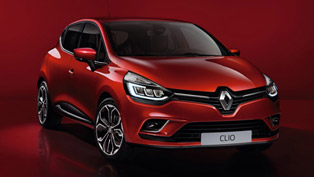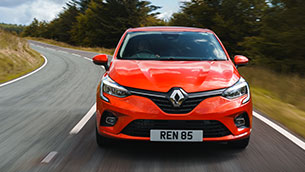Renault Announces its Lowest CO2 Emitting Production Car
Behind the scenes, the development of several of Renault's electric vehicles continues relentlessly ahead of their launch in 2011. Meanwhile, in the pursuit of some purer air before then, the forward-thinking French brand has announced its cleanest production car yet with the new dCi 86-powered Clio, emitting just 98 grams of CO2 per kilometre.
Set to be available in three- and five-door guise, the new versions offer not just reduced guilt driving, but also the promise of lower fuel consumption, at 76.3 mpg (combined cycle, an increase of 12.1 mpg) and a theoretical range of 923 miles between fill-ups.
Such headline-stealing figures have been achieved principally through a series of improvements to the Clio's aerodynamics, engine and tyres. Overall, the new versions offer an impressive 17g/km reduction in CO2 emissions (a gain of 15 per cent) compared to the current mode, without any impact on the car's performance.
The new versions of Clio will sell at the same price as the 115g/km version, a further sign of the Renault eco² signature's aim to make ecological and economical vehicles available to as many motorists as possible.
Clio dCi 86 Renault eco² will be unveiled on 13 January at the Brussels Motor Show, Belgium. Order books will open in France on 9 February and later this year in the UK.

ONGOING CO2 EMISSIONS CUTS ACROSS THE RENAULT RANGE Recognising the importance of addressing the issue of climate change, Renault is committed to attaining a leadership position in CO2 emissions by 2015, not only by cutting the CO2 emissions of its diesel and petrol ranges, but also through the development of its electric vehicle range.
As an essential element in the implementation of its eco² environmental policy, Renault believes it is vital to offer the most effective technologies to the maximum number of customers at an affordable price. In this regard, Renault is already one of the top carmakers in Europe thanks to many years of effort and investment.
INCORPORATION OF LATEST ENGINE DEVELOPMENTS Renault's engineers focused particularly on fine-tuning the dCi 86 powerplant in order to achieve the greatest possible improvement in CO2 emissions levels, without unduly affecting performance.
- Longer gearing across all the transmission ratios: the torque and the flexibility of the dCi 86 allow this to be achieved without any significant impact on performance
- Reduction of frictional losses in the engine and gearbox with the introduction of low-viscosity lubricants
- Dedicated engine mapping focused on reducing fuel consumption and CO2 emissions
REDUCTION OF ROLLING RESISTANCE AND DRAG Improvements to aerodynamics:
- Flexible lip under front bumper extended by 15mm
- Front wheel arch liner extension flaps
- Specific underbody enclosure for rear axle
These aerodynamic improvements have had no adverse effect on Clio's looks, and have notably been achieved without calling on unsightly solutions such as rear lip spoilers or full disc wheel trims.
Reduced rolling resistance:
- Michelin 185x60 R15 low energy consumption tyres
Taken together, these changes bring about a 5 per cent improvement in CdA, taking it from 0.725 to 0.69 and directly benefiting the vehicle's CO2 emissions. The reduction of 17g/km has been achieved without any impact on driving pleasure, comfort or noise levels.
The Clio's range of petrol engine options has also recently boosted by the introduction of a Euro5-compliant TCe 100 with CO2 emissions reduced to 129g/km, representing a gain of 8g/km. This will also save owners £150 in road tax from April.
CLIO dCi 86 RENAULT eco² 98g – TECHNICAL DATA
| ENGINE | |
| Type | K9K |
| Transmission type | Five-speed manual |
| Emissions standard | Euro4 |
| Cubic capacity (cc) | 1,461 |
| Bore x stroke (mm) | 76 x 80.5 |
| Number of cylinders / valves | 4 (in-line) / 8 |
| Compression ratio | 17.9:1 |
| Maximum power (hp) at (rpm) | 86 at 3,750 |
| Maximum torque (Nm) at (rpm) | 200 at 1,900 |
| Fuel injection | Direct common rail |
| Fuel | Diesel |
| Catalytic converter | Standard |
| GEARBOX | |
| Type | JRQ |
| Number of forward speeds | 5 |
| Speed at 1,000rpm: | |
| in 1st gear | 5.55 mph |
| in 2nd gear | 10.10 mph |
| in 3rd gear | 15.66 mph |
| in 4th gear | 21.30 mph |
| in 5th gear | 27.37 mph |
| Ratios | |
| 1st gear | 11/41 |
| 2nd gear | 21/43 |
| 3rd gear | 28/37 |
| 4th gear | 35/34 |
| 5th gear | 41/31 |
| Final drive | 17/56 |
| STEERING | |
| Power steering | Electric variable |
| Turning circle between kerbs / walls (m) | 10.7 / 11 |
| SUSPENSION | |
| Front | MacPherson-type |
| Rear | Programmed-deflection torsion beam |
| Front anti-roll bar diameter (mm) | 20.5 |
| Rear anti-roll bar diameter (mm) | Integrated |
| WHEELS & TYRES | |
| Standard rims (inches) | 6" J15 |
| Standard tyres | Michelin 185x60 R15 |
| BRAKING | |
| Type of circuit | X |
| ABS and emergency brake assist | Standard equipment |
| Electronic brakeforce distribution | Standard equipment |
| ESP with CSV understeer control | Optional |
| Servo (S=single, D=double) – diameter (inches) | S – 10‘' |
| Front: vented discs – diameter (mm) / thickness (mm) | 260 / 22 |
| Rear: drums – diameter (mm) | Drums 203 |
| PERFORMANCE | |
| Drag coefficient (CdA) | 0.69 |
| Top speed (mph) | 109 |
| 0-62 mph (s) | 12.7 |
| 1,000m standing start (s) | 34.4 |
| FUEL CONSUMPTION (litres/100km) – EC Directive 99/100 | |
| CO2 emissions (g/km) | 98 |
| Combined cycle (mpg) | 76.3 |
| FUEL TANK | |
| Capacity (litres) | 55 |
| WEIGHT (kg) | |
| Unladen (kg) | 1,090 |









